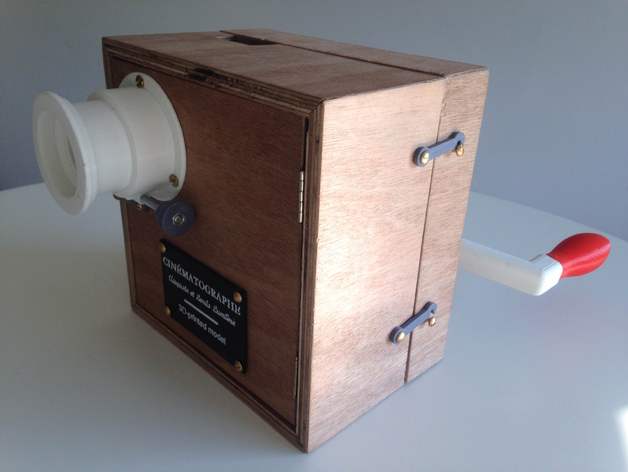
Cinematograph
thingiverse
Introduction The word Cinematograph is derived ancient Greek and means 'writing in movement'. In 1895 the French brother Lumiere invented their 'Cinematographe'. On 28 December 1895 the brothers Lumiere gave their first commercial public screening of cinematographic films in Paris and this had made them famous. With their machine they traveled all over the world, including India en China. People of different social classes could enjoy the moving pictures. The Cinematograph works with a handcrank and a long strip of film. The film is inserted on top of the cinematograph. By moving the crank, the film moved in front of a lens. With help of a light source at the back of the machine, the films where projected on a big screen of 16 by 22 meters. For further information about the Cinematograph see: https://en.wikipedia.org/wiki/Cinematograph The Project The University of Groningen (Netherlands) asked me to make a 3D model of the Cinematograph for educational purposes. There are only 2 original machines available in the Netherlands, so with a 3D model giving instructions about the machine will become much easier. Think of the possibilities with the Hololens or Z-space. Also see: https://sketchfab.com/models/8df1355e552041ada0223acb696abc95 After I saw an original Cinematograph I really fell in love with the mechanism. That's why I decided to make a printable version of the Cinematograph. It took me about a week to design the different parts and make them 3D printer friendly. I designed it for a 9mm-filmstrip, so this replica can be used as a real projector. Building instructions For detailed building instructions, please download the .pdf-file I made. There are 21 different parts. This will take about 13 hours of 3D printing. The box for the first replica was made in a 'traditional' workshop. For Thingiverse I designed some files, so the box can be lasered with a lasercutter. It saves a lot of time and is more accurate. Print Settings Printer: Velleman Vertex K8400 Rafts: No Supports: No Resolution: 0,2 mm Infill: 25% Notes: The file '5. pens', was printed in 0,1mm since these pens are very small. The file '6. Big wheel for pen mechanism' needs to be printed with support. Post-Printing Sanding moving parts The 'layerlines' on the moving parts needs to be sanded down, in order to let the machine function well. This goes for following parts: Moving mechanism: only the 'long ends' that move up and down Pen Mechanism: sand down the square blocks. First sand it with a big grain, like K60 or K80. When the most layerline are removed I always polish it with a smaler grain, like K120 and K240. This give a satin-linke finish to the printed parts. To make sure everthing moves smootlhy I used a little PTFE-spray as a lubricant.
With this file you will be able to print Cinematograph with your 3D printer. Click on the button and save the file on your computer to work, edit or customize your design. You can also find more 3D designs for printers on Cinematograph.
